- Home
- Hip arthritis
- Kellgren Lawrence Grading Scale
Kellgren Lawrence grading scale
Kelgren and Lawrence have produced a useful, and relatively straight forward grading system for X-rays of the arthritic hip. It considers the following criteria:
- Joint space narrowing
- Osteophytic lipping
- Sclerosis
- Bone contour deformity
Chiropractors are faced on a daily basis with stiffness of the hip; mostly it's arthritis in the older person and the impingement syndrome in the younger. The art of good health care is to detect the latter in the early stages before the joint turns to concrete.
Gentle mobilisation, correct anti-inflammatory diet and exercises are the key; and an acceptance that long distance running is verboten.
Kellgren-Lawrence Grade 1
"Doubtful narrowing of joint space and possible osteophytic lipping."
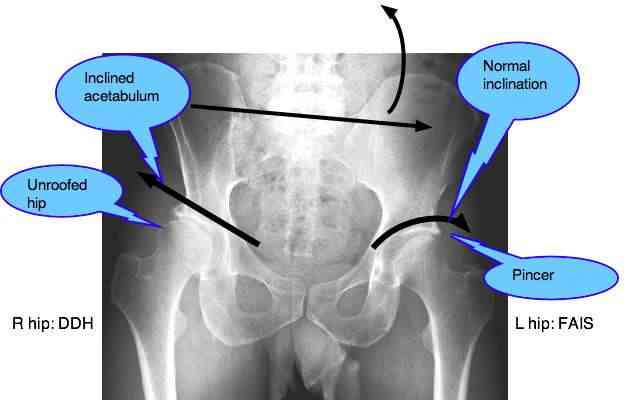
Note in the above X-ray:
- The presence of a short leg. Research indicates a
higher prevalence of hip (and knee) arthritis associated with a leg
length inequality.
LEG LENGTH INEQUALITY Research ...
- In the right hip, the "unroofed" hip and the inclined acetabulum. DEVELOPMENTAL HIP DYSPLASIA is the underlying cause of this hip arthritis.
- In the left hip note the presence of a Pincer deformity: The vital diagnostic question is whether this is
"osteophytic lipping" or just one of the two typical presentations of femoro acetabular impingement syndrome?
- There is "doubtful" narrowing of the joint space in both hips,
and certainly osteophytic lipping / Pincer deformity bilaterally.
- Clinically this 50-year old patient had fairly severe right hip pain and restricted hip flexion and internal rotation; and pain in the groin with walking for the last four years. After 8-10 chiropractic treatments of the hip and sacroiliac joint he says the pain is 70-80% less, and he can ramble relatively normally for the first time in several years. FEMORO ACETABULAR IMPINGEMENT SYNDROME CASE FILE ...
Kellgren Lawrence Grade 2
"Definite osteophytes, definite narrowing of joint space."
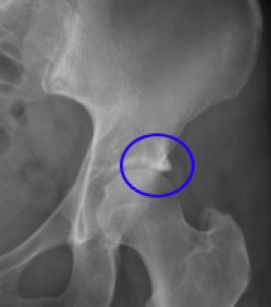
Notice again the presence of a "Pincer" deformity. Earlier this was simply categorised as early osteoarthritis. Now we know it's simply a feature of Femero Acetabular Impingement Syndrome, a condition that in it's early phase responds extremely well to Chiropractic management of the hip, and even in it's more advanced phase, responds moderately well.
Prevention, it is better than a cure.
Neglected it progresses unerringly as in this Kellgren Lawrence grade II case.
Kellgren Lawrence Grade 3
"Moderate multiple osteophytes, definite narrowing of joints space, some sclerosis and possible deformity of bone contour."
This is a letter received recently:
"I am 52-years old with serious arthritis of the hip. Medical treatment to date has not helped and they recommend surgery.
I saw a chiropractor because I had a marked limp and a lot of pain. After only a few treatments the pain and limp are virtually gone.
Thank you for your website."
J
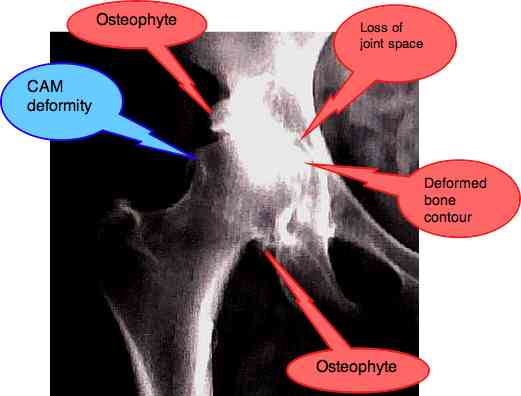
These are the X-rays that J sent me. I suggested she send her chiropractor a bottle of excellent red wine. Maybe a case! Notice the multiple osteophytes, the loss of joint space and the deformity of bone contour of the femoral head. This is verging on Grade 4. Well done, doc.
Notice too the CAM deformity: Femoral Acetabular Impingement Syndrome FAIS, in my opinion should be part of the routine chiropractic examination of each and every patient, especially the young patient.
It takes only 60 seconds to do range of motion tests of the hips after all. Detected at 25, with the correct chiropractic management, I believe this progression to the pain and disability of an arthritic hip, and likely total hip replacement could be prevented.
Kellgren Lawrence Grade 4
"Large osteophytes, marked narrowing of joint space, severe sclerosis and definite deformity of bone contour."
The next two views are not from a Chiropractic clinic. Frankly I think it unlikely that the DC can help a Kellgran Lawrence Grade 4; time to find a good orthopaedic surgeon.
If you have a short leg, ask the surgeon if they can compensate for it. If your pelvis is level, plead with him to make sure that are still that way after the operation.
LEG LENGTH INEQUALITY explains the significance of a short lower limb.
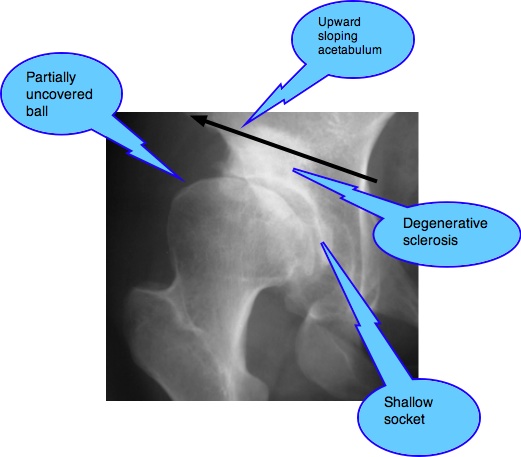
Typical features of how developmental hip dysplasia if not carefully managed leads unerringly to hip arthritis. Notice the shallow socket, the sloping acetabulum and the unroofed femoral head.
Clinical note: every young person complaining of groin pain needs a thorough hip examination, including X-ray. If the range of motion is increased a clear distinction needs to be made: is this hypermobility OR hip dysplasia.
The former can lead a relatively normal life, but in a case like the one above, the young patient with hip dysplasia must accept that some limitation of certain activities is vital if they are to escape disability, pain and total joint replacement.
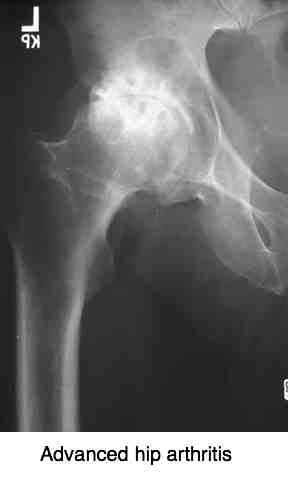
In both these two X-rays we see the typical features of a Kellgren Lawrence Grade 4. The large osteophytes, the dramatic sclerosis and the complete loss of joint space superiorally; and the altered bony contour and cysts within both the acetabulum and ball.
Note in the first the presence of Developmental Hip Dysplasia, and in the second x-ray a CAM deformity of Femoro Acetabular Impingement Syndrome.
In the examination of the hip, DDH has a pronounced INCREASED range of motion, whereas in FAIS the ROM is DECREASED.
In the young adult, a decreased Hip ROM should immediately raise suspicion of FAIS. Treated promptly with chiropractic; a stitch in time may save nine orthopaedic procedures.
Level of activity
Sometimes it may be tragic if FAIS or DDH is detected in a young sports person, but in my opinion they should be immediately advised to live a normal active life, but extreme sports are strictly contraindicated.
The child with DDH is often hypermobile and will excel at gymnastics, but later in life there will be trouble.
Obesity
I have taken an active interest in treating the arthritic hip for more than five years now. I have no figures or research to back me up, but in my experience the obese patient is not likely to respond to the chiropractic management of the arthritic hip. Nor any other treatment, apart from surgery of course.
Unless they are ready to commit to a weight loss programme, I will no longer accept them as a patient. It's a waste of their money, and our time. Sometimes you have to be cruel to be kind...
FREE WEIGHT LOSS PROGRAMS ...Nutrition
For the hyaline cartilage to regenerate, which research in the Netherlands proves it can, it needs to be "unloaded" (= weight-loss), the joint needs to be set in movement (= Chiropractic) and the synovial fluid must contain the right ingredients. A rich soup, fully oxygenated (I have no figures, but I'm fairly sure smokers are less likely to respond well to the chiropratic management of hip arthritis) and rich in glucosamine and chondroitin sulphate.
Unfortunately research shows that patients with hip arthritis do
not respond any better with glucosamine chondroitin suplphate in tablet
form, than patients on a placebo.
GLUCOSAMINE CHONDROITIN sulphate ...
So my nutritional programme for patients with hip arthritis is:
- A home-made chicken bones extract (research from Harvard) for the cartilage.
- Omega 3 capsules
- A tablespoon of freshly ground flax seed . Read about it at
CHIROPRACTIC HELP Obesity in the Chiropractic clinic.
- Regular, at least 2 - 3 times per week, fatty fish.
- WAYS TO COOK SALMON ...
- FISH OIL HEALTH BENEFITS ... make your own fish soup, rich in the ingredients necessary for regrowth of hyaline cartilage
- HYALINE CARTILAGE ... what is it?
Kellgren Lawrence grading scale
Kellgren Lawrence grading scale measures how bad your arthritis is?
- Home
- Hip arthritis
- Kellgren Lawrence Grading Scale
Did you find this page useful? Then perhaps forward it to a suffering friend. Better still, Tweet or Face Book it.
